turn signal bulb GMC YUKON XL 2006 Owners Manual
[x] Cancel search | Manufacturer: GMC, Model Year: 2006, Model line: YUKON XL, Model: GMC YUKON XL 2006Pages: 540, PDF Size: 3 MB
Page 168 of 540
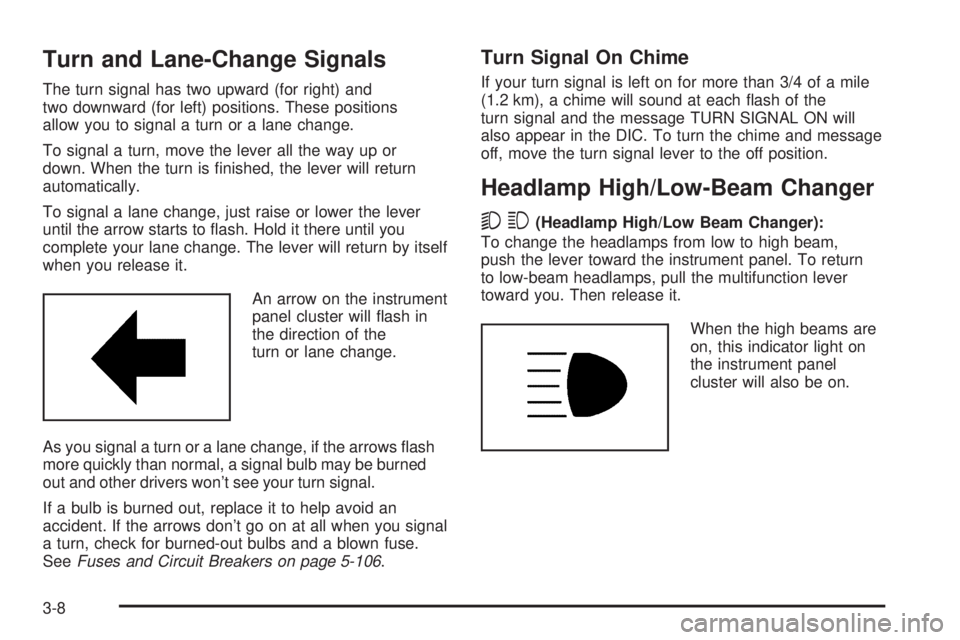
Turn and Lane-Change Signals
The turn signal has two upward (for right) and
two downward (for left) positions. These positions
allow you to signal a turn or a lane change.
To signal a turn, move the lever all the way up or
down. When the turn is �nished, the lever will return
automatically.
To signal a lane change, just raise or lower the lever
until the arrow starts to �ash. Hold it there until you
complete your lane change. The lever will return by itself
when you release it.
An arrow on the instrument
panel cluster will �ash in
the direction of the
turn or lane change.
As you signal a turn or a lane change, if the arrows �ash
more quickly than normal, a signal bulb may be burned
out and other drivers won’t see your turn signal.
If a bulb is burned out, replace it to help avoid an
accident. If the arrows don’t go on at all when you signal
a turn, check for burned-out bulbs and a blown fuse.
SeeFuses and Circuit Breakers on page 5-106.
Turn Signal On Chime
If your turn signal is left on for more than 3/4 of a mile
(1.2 km), a chime will sound at each �ash of the
turn signal and the message TURN SIGNAL ON will
also appear in the DIC. To turn the chime and message
off, move the turn signal lever to the off position.
Headlamp High/Low-Beam Changer
53(Headlamp High/Low Beam Changer):
To change the headlamps from low to high beam,
push the lever toward the instrument panel. To return
to low-beam headlamps, pull the multifunction lever
toward you. Then release it.
When the high beams are
on, this indicator light on
the instrument panel
cluster will also be on.
3-8
Page 367 of 540
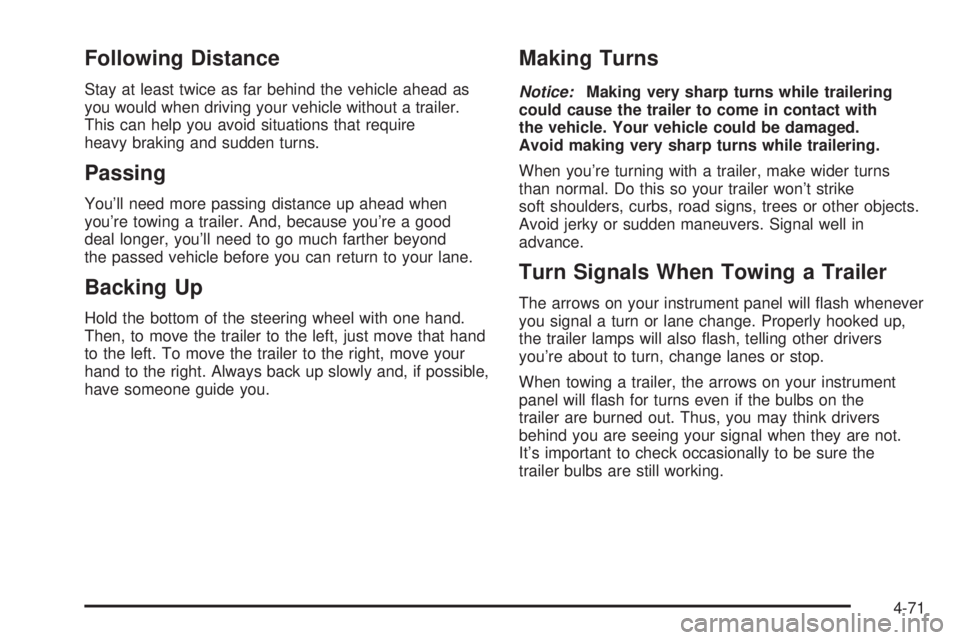
Following Distance
Stay at least twice as far behind the vehicle ahead as
you would when driving your vehicle without a trailer.
This can help you avoid situations that require
heavy braking and sudden turns.
Passing
You’ll need more passing distance up ahead when
you’re towing a trailer. And, because you’re a good
deal longer, you’ll need to go much farther beyond
the passed vehicle before you can return to your lane.
Backing Up
Hold the bottom of the steering wheel with one hand.
Then, to move the trailer to the left, just move that hand
to the left. To move the trailer to the right, move your
hand to the right. Always back up slowly and, if possible,
have someone guide you.
Making Turns
Notice:Making very sharp turns while trailering
could cause the trailer to come in contact with
the vehicle. Your vehicle could be damaged.
Avoid making very sharp turns while trailering.
When you’re turning with a trailer, make wider turns
than normal. Do this so your trailer won’t strike
soft shoulders, curbs, road signs, trees or other objects.
Avoid jerky or sudden maneuvers. Signal well in
advance.
Turn Signals When Towing a Trailer
The arrows on your instrument panel will �ash whenever
you signal a turn or lane change. Properly hooked up,
the trailer lamps will also �ash, telling other drivers
you’re about to turn, change lanes or stop.
When towing a trailer, the arrows on your instrument
panel will �ash for turns even if the bulbs on the
trailer are burned out. Thus, you may think drivers
behind you are seeing your signal when they are not.
It’s important to check occasionally to be sure the
trailer bulbs are still working.
4-71
Page 375 of 540
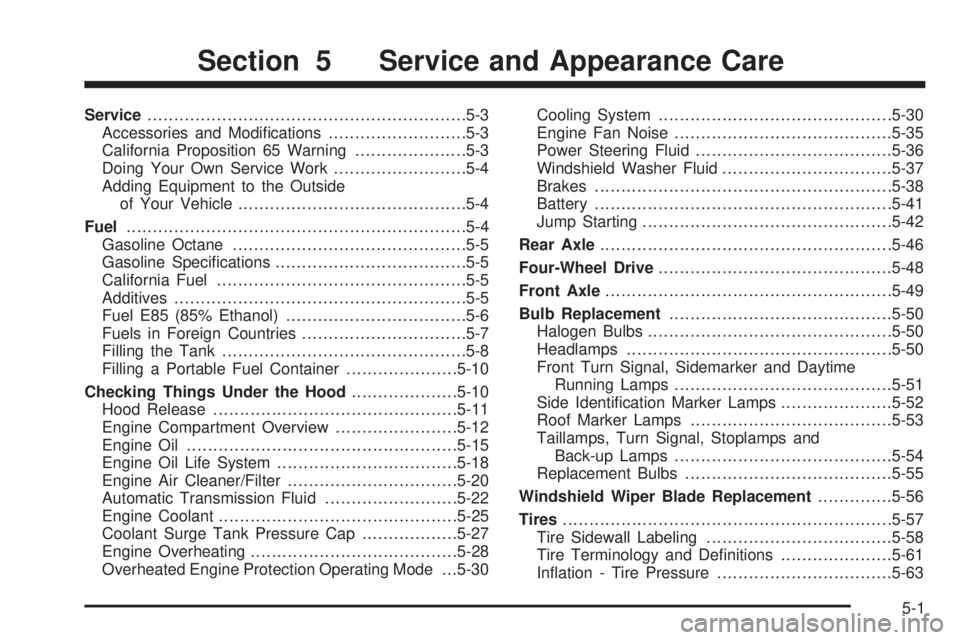
Service............................................................5-3
Accessories and Modi�cations..........................5-3
California Proposition 65 Warning.....................5-3
Doing Your Own Service Work.........................5-4
Adding Equipment to the Outside
of Your Vehicle...........................................5-4
Fuel................................................................5-4
Gasoline Octane............................................5-5
Gasoline Speci�cations....................................5-5
California Fuel...............................................5-5
Additives.......................................................5-5
Fuel E85 (85% Ethanol)..................................5-6
Fuels in Foreign Countries...............................5-7
Filling the Tank..............................................5-8
Filling a Portable Fuel Container.....................5-10
Checking Things Under the Hood....................5-10
Hood Release..............................................5-11
Engine Compartment Overview.......................5-12
Engine Oil...................................................5-15
Engine Oil Life System..................................5-18
Engine Air Cleaner/Filter................................5-20
Automatic Transmission Fluid.........................5-22
Engine Coolant.............................................5-25
Coolant Surge Tank Pressure Cap..................5-27
Engine Overheating.......................................5-28
Overheated Engine Protection Operating Mode . . .5-30Cooling System............................................5-30
Engine Fan Noise.........................................5-35
Power Steering Fluid.....................................5-36
Windshield Washer Fluid................................5-37
Brakes........................................................5-38
Battery........................................................5-41
Jump Starting...............................................5-42
Rear Axle.......................................................5-46
Four-Wheel Drive............................................5-48
Front Axle......................................................5-49
Bulb Replacement..........................................5-50
Halogen Bulbs..............................................5-50
Headlamps..................................................5-50
Front Turn Signal, Sidemarker and Daytime
Running Lamps.........................................5-51
Side Identi�cation Marker Lamps.....................5-52
Roof Marker Lamps......................................5-53
Taillamps, Turn Signal, Stoplamps and
Back-up Lamps.........................................5-54
Replacement Bulbs.......................................5-55
Windshield Wiper Blade Replacement..............5-56
Tires..............................................................5-57
Tire Sidewall Labeling...................................5-58
Tire Terminology and De�nitions.....................5-61
In�ation - Tire Pressure.................................5-63
Section 5 Service and Appearance Care
5-1
Page 425 of 540
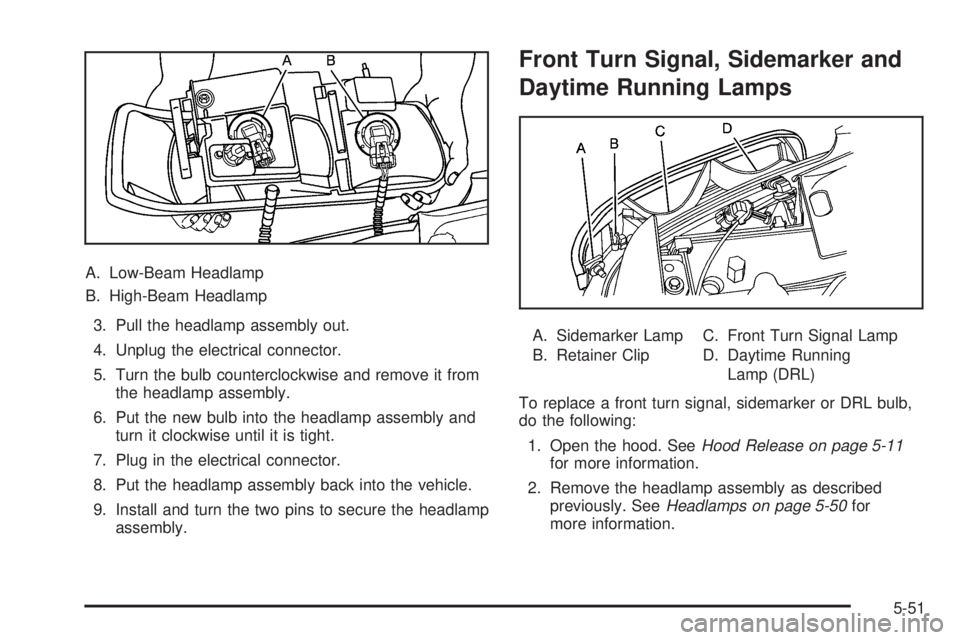
A. Low-Beam Headlamp
B. High-Beam Headlamp
3. Pull the headlamp assembly out.
4. Unplug the electrical connector.
5. Turn the bulb counterclockwise and remove it from
the headlamp assembly.
6. Put the new bulb into the headlamp assembly and
turn it clockwise until it is tight.
7. Plug in the electrical connector.
8. Put the headlamp assembly back into the vehicle.
9. Install and turn the two pins to secure the headlamp
assembly.
Front Turn Signal, Sidemarker and
Daytime Running Lamps
A. Sidemarker Lamp
B. Retainer ClipC. Front Turn Signal Lamp
D. Daytime Running
Lamp (DRL)
To replace a front turn signal, sidemarker or DRL bulb,
do the following:
1. Open the hood. SeeHood Release on page 5-11
for more information.
2. Remove the headlamp assembly as described
previously. SeeHeadlamps on page 5-50for
more information.
5-51
Page 426 of 540
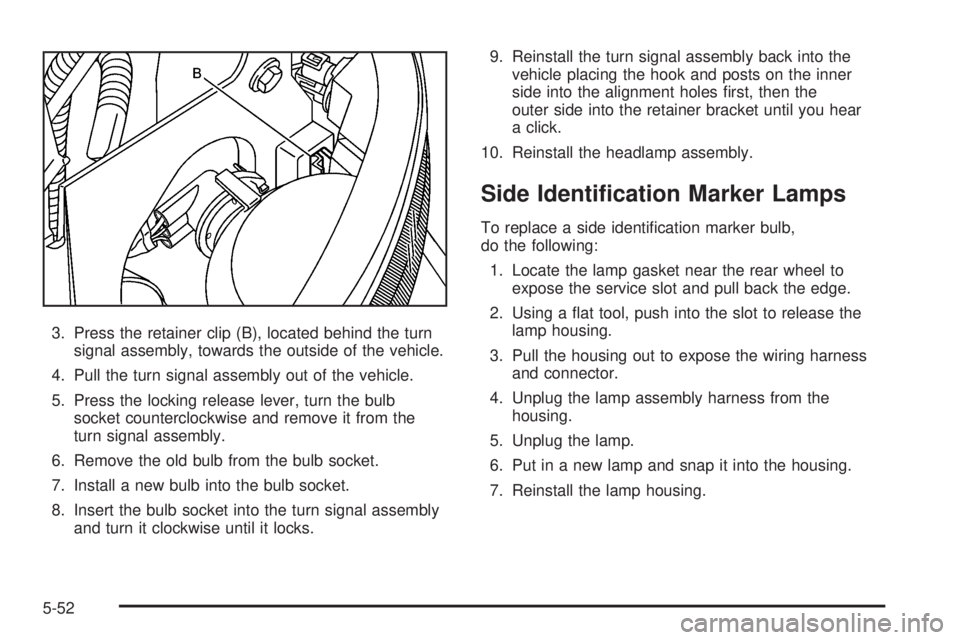
3. Press the retainer clip (B), located behind the turn
signal assembly, towards the outside of the vehicle.
4. Pull the turn signal assembly out of the vehicle.
5. Press the locking release lever, turn the bulb
socket counterclockwise and remove it from the
turn signal assembly.
6. Remove the old bulb from the bulb socket.
7. Install a new bulb into the bulb socket.
8. Insert the bulb socket into the turn signal assembly
and turn it clockwise until it locks.9. Reinstall the turn signal assembly back into the
vehicle placing the hook and posts on the inner
side into the alignment holes �rst, then the
outer side into the retainer bracket until you hear
a click.
10. Reinstall the headlamp assembly.
Side Identi�cation Marker Lamps
To replace a side identi�cation marker bulb,
do the following:
1. Locate the lamp gasket near the rear wheel to
expose the service slot and pull back the edge.
2. Using a �at tool, push into the slot to release the
lamp housing.
3. Pull the housing out to expose the wiring harness
and connector.
4. Unplug the lamp assembly harness from the
housing.
5. Unplug the lamp.
6. Put in a new lamp and snap it into the housing.
7. Reinstall the lamp housing.
5-52
Page 428 of 540

Taillamps, Turn Signal, Stoplamps
and Back-up Lamps
A. Turn Signal Lamp
B. Back-up Lamp
C. Stoplamp/TaillampTo replace one of these bulbs, do the following:
1. Remove the
two screws from
the taillamp
assembly.
2. Remove the taillamp assembly.
3. Press the release tab, if equipped, and turn the
socket counterclockwise to remove it from the
taillamp housing.
5-54
Page 429 of 540
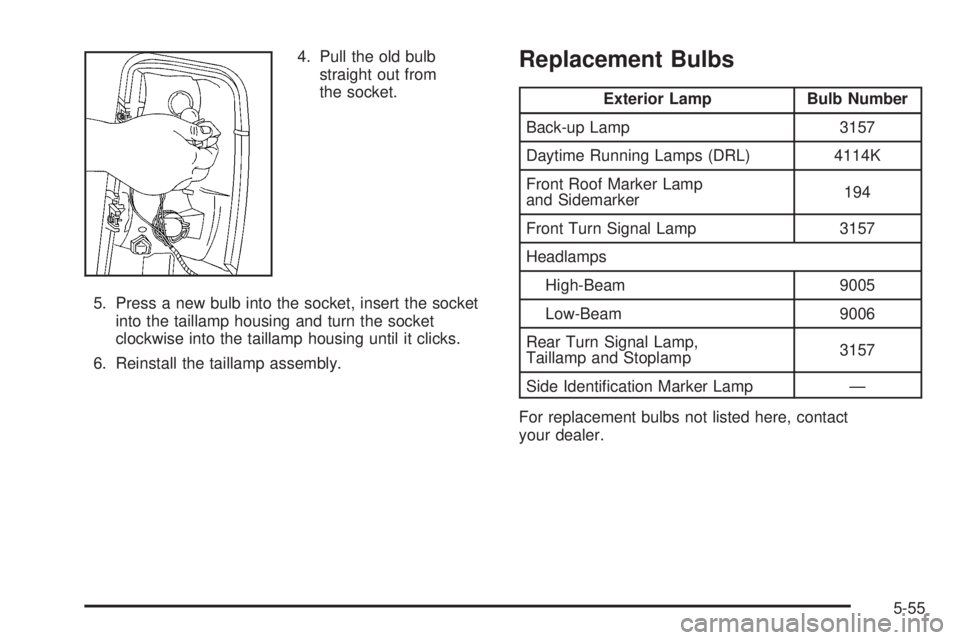
4. Pull the old bulb
straight out from
the socket.
5. Press a new bulb into the socket, insert the socket
into the taillamp housing and turn the socket
clockwise into the taillamp housing until it clicks.
6. Reinstall the taillamp assembly.Replacement Bulbs
Exterior Lamp Bulb Number
Back-up Lamp 3157
Daytime Running Lamps (DRL) 4114K
Front Roof Marker Lamp
and Sidemarker194
Front Turn Signal Lamp 3157
Headlamps
High-Beam 9005
Low-Beam 9006
Rear Turn Signal Lamp,
Taillamp and Stoplamp3157
Side Identi�cation Marker Lamp —
For replacement bulbs not listed here, contact
your dealer.
5-55
Page 528 of 540
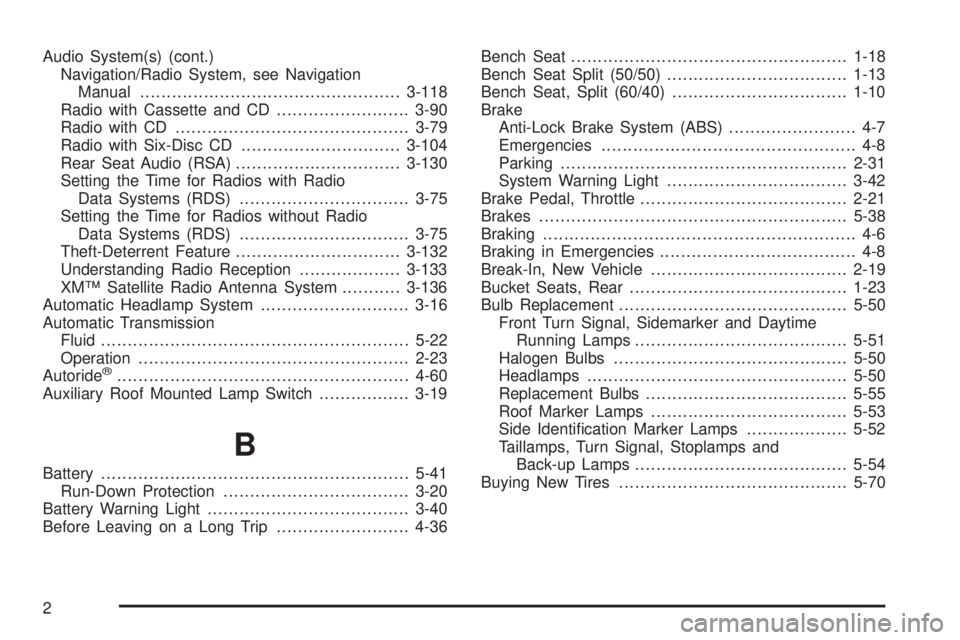
Audio System(s) (cont.)
Navigation/Radio System, see Navigation
Manual.................................................3-118
Radio with Cassette and CD.........................3-90
Radio with CD............................................3-79
Radio with Six-Disc CD..............................3-104
Rear Seat Audio (RSA)...............................3-130
Setting the Time for Radios with Radio
Data Systems (RDS)................................3-75
Setting the Time for Radios without Radio
Data Systems (RDS)................................3-75
Theft-Deterrent Feature...............................3-132
Understanding Radio Reception...................3-133
XM™ Satellite Radio Antenna System...........3-136
Automatic Headlamp System............................3-16
Automatic Transmission
Fluid..........................................................5-22
Operation...................................................2-23
Autoride
®.......................................................4-60
Auxiliary Roof Mounted Lamp Switch.................3-19
B
Battery..........................................................5-41
Run-Down Protection...................................3-20
Battery Warning Light......................................3-40
Before Leaving on a Long Trip.........................4-36Bench Seat....................................................1-18
Bench Seat Split (50/50)..................................1-13
Bench Seat, Split (60/40).................................1-10
Brake
Anti-Lock Brake System (ABS)........................ 4-7
Emergencies................................................ 4-8
Parking......................................................2-31
System Warning Light..................................3-42
Brake Pedal, Throttle.......................................2-21
Brakes..........................................................5-38
Braking........................................................... 4-6
Braking in Emergencies..................................... 4-8
Break-In, New Vehicle.....................................2-19
Bucket Seats, Rear.........................................1-23
Bulb Replacement...........................................5-50
Front Turn Signal, Sidemarker and Daytime
Running Lamps........................................5-51
Halogen Bulbs............................................5-50
Headlamps.................................................5-50
Replacement Bulbs......................................5-55
Roof Marker Lamps.....................................5-53
Side Identi�cation Marker Lamps...................5-52
Taillamps, Turn Signal, Stoplamps and
Back-up Lamps........................................5-54
Buying New Tires...........................................5-70
2
Page 532 of 540
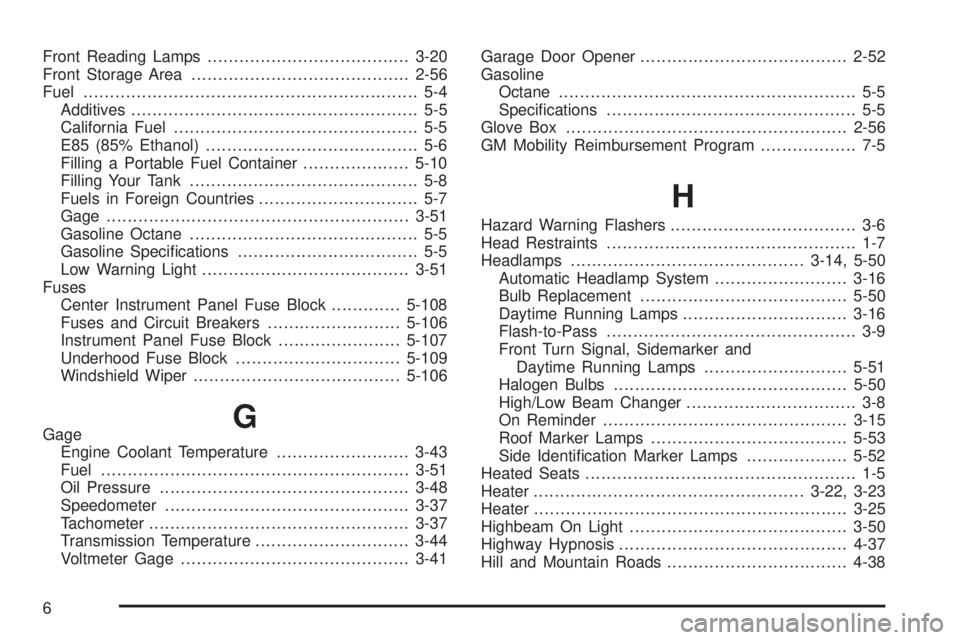
Front Reading Lamps......................................3-20
Front Storage Area.........................................2-56
Fuel............................................................... 5-4
Additives...................................................... 5-5
California Fuel.............................................. 5-5
E85 (85% Ethanol)........................................ 5-6
Filling a Portable Fuel Container....................5-10
Filling Your Tank........................................... 5-8
Fuels in Foreign Countries.............................. 5-7
Gage.........................................................3-51
Gasoline Octane........................................... 5-5
Gasoline Speci�cations.................................. 5-5
Low Warning Light.......................................3-51
Fuses
Center Instrument Panel Fuse Block.............5-108
Fuses and Circuit Breakers.........................5-106
Instrument Panel Fuse Block.......................5-107
Underhood Fuse Block...............................5-109
Windshield Wiper.......................................5-106
GGage
Engine Coolant Temperature.........................3-43
Fuel..........................................................3-51
Oil Pressure...............................................3-48
Speedometer..............................................3-37
Tachometer.................................................3-37
Transmission Temperature.............................3-44
Voltmeter Gage...........................................3-41Garage Door Opener.......................................2-52
Gasoline
Octane........................................................ 5-5
Speci�cations............................................... 5-5
Glove Box.....................................................2-56
GM Mobility Reimbursement Program.................. 7-5
H
Hazard Warning Flashers................................... 3-6
Head Restraints............................................... 1-7
Headlamps............................................3-14, 5-50
Automatic Headlamp System.........................3-16
Bulb Replacement.......................................5-50
Daytime Running Lamps...............................3-16
Flash-to-Pass............................................... 3-9
Front Turn Signal, Sidemarker and
Daytime Running Lamps...........................5-51
Halogen Bulbs............................................5-50
High/Low Beam Changer................................ 3-8
On Reminder..............................................3-15
Roof Marker Lamps.....................................5-53
Side Identi�cation Marker Lamps...................5-52
Heated Seats................................................... 1-5
Heater...................................................3-22, 3-23
Heater...........................................................3-25
Highbeam On Light.........................................3-50
Highway Hypnosis...........................................4-37
Hill and Mountain Roads..................................4-38
6